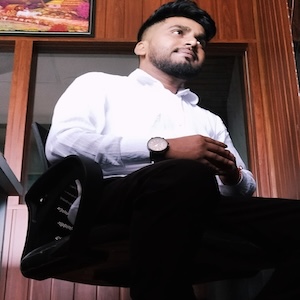Class 12 Anthropology Chapter 1 Cell Biology, HS 2nd year Anthropology notes, Anthropology Class 12 Question Answer to each chapter is provided in the list so that you can easily browse throughout different chapters SCERT Class 12 Anthropology Chapter 1 Cell Biology and select needs one.
Class 12 Anthropology Chapter 1 Cell Biology
Also, you can read the SCERT book online in these sections Solutions by Expert Teachers as per SCERT (CBSE) Book guidelines. AHSEC Class 12 Anthropology Chapter 1 Cell Biology is part of AHSEC All Subject Solutions. Here we have given Assam Board Class 12 Anthropology Chapter 1 Cell Biology Notes for All Subjects, You can practice these here.
Cell Biology
Chapter – 1
| QUESTIONS |
1. Who noticed the human cell for the first time?
Ans: Robert Hooks noticed the human cells for the first time.
2. What are the two main parts of the cell?
Ans: The two main parts of a cell are the cytoplasm and the nucleus.
3. What are the two main types of human cell?
Ans: The two main types of human cell are:
(i) Somatic cell or body cell.
(ii) Germ cell or reproductive cell.
4. Define human cell.
Ans: A human cell is the basic structural and functional unit of the human body. It is a microscopic unit that carries out essential life processes such as growth, metabolism, and reproduction. Human cells contain a nucleus, which houses genetic material (DNA), and various organelles like mitochondria, ribosomes, and the endoplasmic reticulum, each performing specific functions.
5. What do you mean by cell division?
Ans: Cell division in unicellular organisms is nothing but reproduction by which non individuals are produced whereas in multicellular organisms, single zygote undergoes repeated divisions and gives rise to a complex body with different organ systems.
6. Who put forward the idea of cell division?
Ans: Lowey and Seikevitz put forward the idea of cell division in 1963.
7. What are the main stages of mitosis cell division?
Ans: The main stages of mitosis cell division are as follow:
(i) Prophase: At the beginning of the prophase stage the cell prepares itself to divide the chromosomes. It was long, slender and loosely packed in the resting stage, gradually contracting and thickening owing to coiling and the apposition of material. Each chromosome is seen to be made up of two identical strands or chromatids lying against each other throughout their length. A chromosome bears a constriction or a narrow region of attachment to the spindle which is called a ‘centromere.’ Other constrictions are also seen other than centromeres which are called “secondary constrictions”. In the prophase stage the centromere and secondary centrictions are similar. As prophase advances the chromatids become closely coiled and thus the double nature of the chromosomes disappears.
(ii) Metaphase: In this stage the nucleolus and nuclear (membrane disappear and a spindle shaped body known as nuclear spindle is formed. The spindle extends into the nuclear area and occupies the centre of the cell. The chromosomes move to the equatorial plane of the spindle and become attached to it by the centromeres. Thus, metaphase is a stage during which little or no visible change takes place in the cell; it is a static phase and usually a short one.
(iii) Anaphase: The chromosomes begin to separate. Each centromere divides equally. First the two centromeres and later on the chromatids are pulled apart. The two halves or the identical sets of chromatids move to opposite poles of the spindle. The movement of the chromatids is autonomous. Thus the chromatids become separated from each other. After a complete separation of the chromatids from one another, they are called daughter chromosomes.
(iv) Telophase: In this stage, chromosomes group themselves and reconstitute daughter nuclei between which cell membrane soon forms. The two groups of chromatids now known as chromosomes pass towards opposite poles of the spindle. Then the chromosomes uncoil and again become thin and long. The polar caps of the spindle disappear; and the nuclear membrane encircling the chromosome develops, nucleoli reappear. As the telophase proceeds the division of cytoplasm into two parts also takes place. And ultimately two daughter cells are formed.
8. Who described the word chromosome for the first time?
Ans: Chromosome was first described by Strausburger in 1875.
9. How many chromosomes are there in the human body?
Ans: Humans typically have 23 pairs of chromosomes, or 46 chromosomes in number are there in the human body.
10. Write the names of protein found in chromosome.
Ans: The names of proteins found in chromosomes are Histone and Non – histone.
11. What is the root word for gene?
Ans: The word gene has been derived from a Greek word genom means to produce.
12. Draw a human cell and describe its different parts.
Ans:
13. Describe the mitosis cell division?
Ans: The changes that occur in the cell nucleus during mitosis are divided into four stages. Those sections are:
(i) Prophase.
(ii) The middle layer (Metaphase).
(iii) Anaphase.
(iv) Telophase.
The above sections are discussed in more detail below –
(i) Prophase: The first stage of nucleus division is the prophase. of cell division. During startup, the cell is stationary. As this stage begins, the nucleus becomes slightly larger in size and the nucleus reticulum disappears. The chromosome in the nucleus reticulum is converted thread-shaped chromosomes. At the beginning of this division, the chromosomes take the shape of a curved thread of cacao and each chromosome divides lengthwise into two parts by the method of nucleopathy. The two parts are homogeneous.
(ii) Metaphase: With the onset of metaphase, the nucleus and the nuclear envelope of the nucleus become completely invisible. Cytoplasmic fibers move from the two poles of the cell to the middle part of the cell. This makes the middle thicker and gradually thicker on both sides. This is called the central mohura. This cavity extends from end to end to the middle of the cell.
(iii) Anaphase: The chromatid is condensed into two opposite makers.The marginal level begins as it moves laterally. In this condition, the chromosomes separate from each other. Fibers attached to the centromere begin to pull the chromatid to two mechs. Thus one of the homologous chromatids moves to one pole and the other to the mech.
(iv) Telophase: At the end of the movement in the telophase, the chromosomes are in two mechs of the cell. They are clustered. These chromatids are called chromosomes. Gradually, the chromosomes become finer and longer, leaving the twisted state and assuming their previous shape. That is, it gradually becomes obscure. The cocoon has already disappeared. Instead, the chromosomes are surrounded by the nuclear envelope. The nucleolus also preforms.
14. Write the differences between mitosis and meiosis cell division.
Ans: The differences between mitosis and meiosis cell division are:
| Mitosis Cell | Meiosis cell |
| (i) A type of cell division that results in two genetically identical daughter cells. | (i) A type of cell division that reduces the chromosome number by half, producing four genetically different daughter cells. |
| (ii) Mitosis occurs in somatic cells. | (ii) Meiosis occurs in germ cells. |
| (iii) Only one nuclear division occurs. | (iii) Two nuclear divisions occur. |
| (iv) Mother cell can either be haploid or diploid. | (iv) The mother cell is always diploid. |
| (v) Found in all organisms for growth and repair. | (v) Found only in sexually reproducing organisms. |
15. Show the different parts of a human chromosome.
Ans:
16. What are the different parts of a chromosome?
Ans: The different parts of a chromosome are:
(i) Pellicle and Chromonema: Each chromosome has an outer, membranous covering called pellicle below which lies a substance called matrix or hyalonema. Within the chromosome is found a coiled filamentous structure called chromonema. On chromonema there are minutes bead like structures called chromomeres. The space between two centromeres in called inter-chromomere.
(ii) Primary constriction and centromere: Generally a chromosome has two arms. The constriction between the two arms is the primary constriction and the spherical granular part is the centromere. During cell division spindle fibres are attached at this point.
(iii) Secondary constriction 1 or Nucleolar Organisers: Near one end of the chromosome there is another constriction which is the secondary constriction 1 or nucleolar organizer as it is essential for the formation of nucleolus. The two parts lying one on the each side of the constriction do not make an angle. The nucleolar organizer generally is in contract with nucleolus. The organizers contains a little amount (0.3%) of DNA which synthesised mainly the 28 s r-RNA. So it is believed that this is the loci of few genes.
(iv) Secondary constriction II: This is another constriction at any part of the chromosome. The point of this constriction is definite for a specific chromosome. It differs from primary constriction in the fact that the arms do not make any angle at this point.
(v) Satellite: The part of the chromosome next to the nucleolar organizer is generally round and is known as a satellite. The chromosome having this part is called SAT-chromosome.
(vi) Telomere: The two extreme ends of a chromosome are called telomeres. It possesses a peculiar property. Due to this the two extreme ends of a chromosome will never fuse. If one chromosome is broken due to any reason the broken ends will not fuse with telomere.
17. What are the different types of nucleic acid and write their names?
Ans: There are two kinds of nucleic acids like deoxyribonucleic acid (DNA) and ribonucleic acid (RNA).
18. Who for the first time used the words mitosis meiosis?
Ans: Walter Flemming was the first person to observe mitosis in detail in 1882. The term meiosis was carried by Farmer & Moore in 1905.
19. What is the meaning of the word chromosome?
Ans: The word chromosome comes from the Greek words “chroma” means color and “soma” means body.
20. Who used the word enzymes for the first time?
Ans: The word ‘enzyme’ was first used by Friedrich Withelm Kuhne in 1878.
21. Write the functions of enzymes.
Ans: Enzymes are found all around the situations.To function properly all living organism need enzymes to know the chemical prospects. It is seen that enzymes are naturally occurred protein and their basic function is to speed up the process of and efficiency of a chemical reaction without being consumed in the process. Enzymes are instrumental substances to many functions of living organism, which are totally biological.
Following are the functions of enzymes:
(i) Signal Transduction: In signal transduction enzymes are competent by participating in a chemical or physical signal which is transmitted through a cell as a series of molecular events, and a cellular response. Which is appeared at last. The protein kinases that catalyzed protein phosphorylation is the most important enzymes activities in signal transduction.
(ii) Macromolecular Degradation: The human body easily can absorbed the large molecules which are broken down by enzymes into small fragments. The human body cannot be up taken many nutritional ingredients which are there in the form of large molecules such as sugar proteins and fat. The enzymes broken down these ingredients into smaller pieces before absorption and this process is known as catabolism. After absorption the small molecules will be used as building blocks to refresh the body through tissue repairing, regeneration and growth and this process is know as anabolism Like amylases and proteases enzymes are employed in catabolism and anabolism.
(iii) Energy Generation: In living organism the energy is generated by enzymes. In living organism ATP (Adenosine triphosphate) is the main storage from of chemical energy. For biological activities from ATP only one can get the energy. To store energy in ATP molecules enzymes are act as a transformer to turn energy into proper chemical forms. Such of these enzymes are called ATP synthesis.
(iv) Ion Pumps: In active transport mechanism some enzymes in the cell membrane act as ion pumps to move ions across a plasma membrane against their concentration gradient. These primary ions transporters could convert energy from various sources including ATP. Sunlight and other redox reactions, to potential energy stored in an electrochemical gradient.
(v) Defence and clearance: From the external environment in any organisms there are always some non nutritive substances produced by environment or by the body itself which cannot be either transformed into cellular constituents or employed as energy source. They need to be converted into products to be excluded or utilised as physiological, pathological or toxicological components. In this procedure enzyme can only or by complex encompassing various enzymes or an enzyme system which perform a series of biochemical reactions though oxidation, reduction, hydrolysis and so on.
(vi) Cell Regulation: To regulate cell activities enzymes can move parts of a cell’s internal structure and reorganize them. From one part to another inside cells they deliver packages and pull chromosomes apart when the cells undergo mitosis and pull cilia to trigger cell movement or to help cells move mucus up in airway to clear it. In this movement the myosin AT Pase kineshin AT pase, and devein AT Pase is acting.
Other functions are the following acts are doing by enzyme:
(i) Enzyme able to generate movement with myosin.
(ii) Hydrolyzing ATP to generate muscle contraction and.
(iii) Transport intracellular substances around the cell as part of the cytoskeleton.

Hi! my Name is Parimal Roy. I have completed my Bachelor’s degree in Philosophy (B.A.) from Silapathar General College. Currently, I am working as an HR Manager at Dev Library. It is a website that provides study materials for students from Class 3 to 12, including SCERT and NCERT notes. It also offers resources for BA, B.Com, B.Sc, and Computer Science, along with postgraduate notes. Besides study materials, the website has novels, eBooks, health and finance articles, biographies, quotes, and more.




